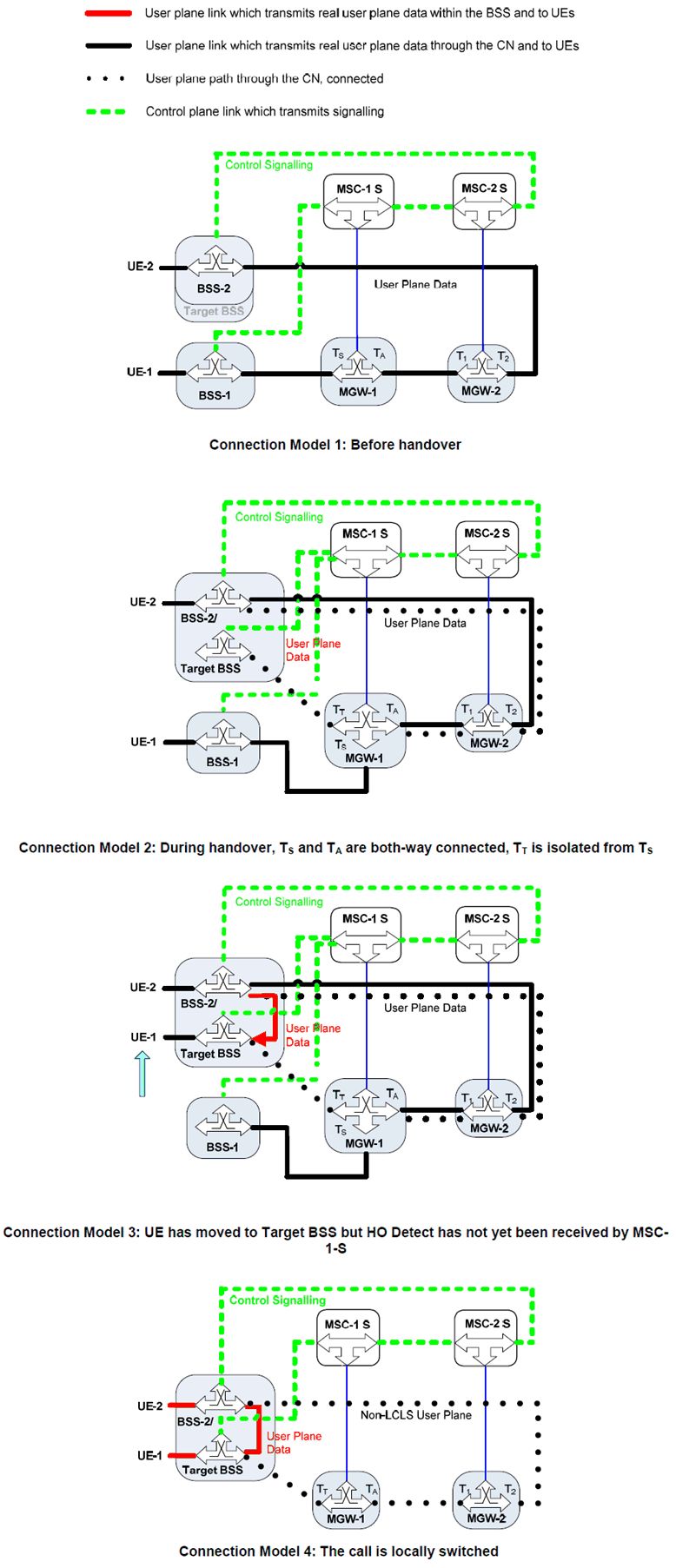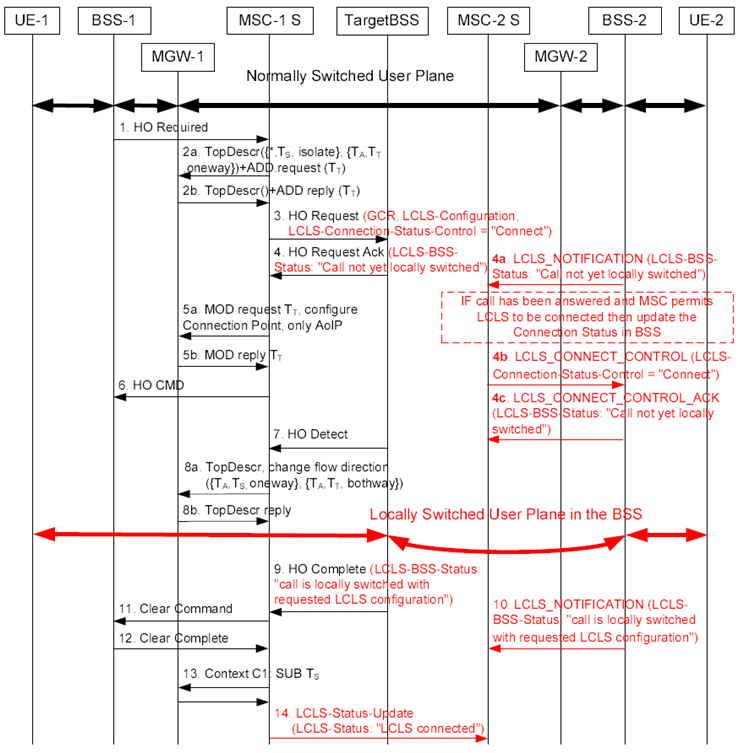Content for TS 23.284 Word version: 17.0.0
1…
4…
4.2…
4.3…
5
6…
6.3…
6.3.2
6.3.3
6.3.4
6.3.5
7…
7.2.4…
7.2.4.2
7.2.4.3
7.2.4.4
7.2.4.5
7.2.4.6
7.3…
7.3.4…
7.3.4.2
7.3.4.3
7.3.4.4
8…
8.2.3
8.3…
8.3.2
8.4…
8.4.1.1.7…
8.4.1.2…
8.4.2…
8.4.2.2…
8.4.5…
8.4.5.6
8.4.5.7
8.4.5.8…
9…
13…
13.4…
13.4.3…
13.4.4…
13.5…
13.6…
13.7…
14…
16…
A…
A.2…
8.4.1.2 Intra-MSC Inter-BSS GSM to GSM Handovers that establishes Local Switching
8.4.1.2.1 General
8.4.1.2.2 Handover Required
8.4.1.2.3 Bearer establishment towards Target BSS
8.4.1.2.4 MGW Flow Direction Control
8.4.1.2.5 Handover Request Acknowledge
8.4.1.2.6 Handover Command/Handover Detect
8.4.1.2.7 Handover Complete
8.4.1.2.8 Example
...
...
8.4.1.2 Intra-MSC Inter-BSS GSM to GSM Handovers that establishes Local Switching p. 97
8.4.1.2.1 General p. 97
When LCLS is not established for a call and an intra-MSC inter-BSS GSM to GSM handover occurs that makes the call local, the call should be locally switched in the BSS. The Intra-MSC inter-BSS GSM to GSM handover procedures specified in TS 23.009, TS 23.205 and TS 23.231 shall be followed. The following clauses describe the additional requirements for intra-MSC handovers that establish LCLS.
8.4.1.2.2 Handover Required p. 97
When the MSC server receives the Handover Required message from the serving BSS, it requests the MGW to seize a TDM circuit if AoTDM or an IP termination if AoIP for the termination to the Target BSS as for the normal handover procedure. The MSC server shall use the Change Flow Direction procedure to request the MGW to set the Handover Device to the initial state.
8.4.1.2.3 Bearer establishment towards Target BSS p. 97
When the MSC-Server has selected the Target MGW it requests the Target MGW to seize a TDM circuit if AoTDM using the Reserve Circuit procedure, or an IP termination if AoIP using the reserve Connection Point procedure as for the normal handover procedure. The MSC-Server sends the Handover Request message to the Target BSS containing the CIC for AoTDM or the IP addresses and UDP ports received from the target MGW if AoIP.
8.4.1.2.4 MGW Flow Direction Control p. 97
In accordance with the normal handover case the MGW-1 isolates the termination towards the Target BSS (TT) from the termination to the Serving BSS (TS) and configures the Anchor termination (TA) one-way DL towards the Target BSS termination (TT). Termination to the Serving BSS (TS) is both-way connected to Anchor termination (TA) since it is also receiving UL user data from termination to the Serving BSS (TS).
8.4.1.2.5 Handover Request Acknowledge p. 97
If the Target BSS supports the LCLS feature it shall include the LCLS-BSS-Status IE in the Handover Request Acknowledge message in order to inform the anchor MSC Server that the BSS supports the LCLS feature.
The anchor MSC Server shall not act upon the status indicated, i.e. no signalling of LCLS-Status IE through the core network.
8.4.1.2.6 Handover Command/Handover Detect p. 98
The anchor MSC Server shall use the Change Flow Direction procedure to requests the MGW-1 to set the Handover Device to intermediate state.
8.4.1.2.7 Handover Complete p. 98
When the MSC-Server receives the Handover Complete message, it releases the A-interface line towards the serving BSS. The MSC-Server also requests the MGW to set the Handover Device to its final state by removing the bearer termination towards the serving BSS.
When LCLS has been established during the handover procedure, the target BSS informs the anchor MSC-Server that the call has been locally switched in the Handover Complete message.
The MSC-Server shall send to the adjacent call node the LCLS-Status-Update message with the LCLS-Status IE indicating that LCLS was established.
8.4.1.2.8 Example p. 98
8.4.1.2.8.1 Connection Model p. 98
Figure 8.4.1.2.8.1.1 shows the network model for the Intra-MSC Inter-BSS GSM to GSM Handover, where the call leg pertinent to the UE-1 is handed over from the serving BSS-1 to the Target BSS. Target BSS is the same as BSS-2 when LCLS is established for the call. The bearer termination T2 is used for the bearer towards BSS-2, which is not affected by this handover. Bearer termination TS is used for the bearer towards BSS-1 and the bearer terminations T1 and TA are used for the bearer towards the succeeding/preceding MGW. Bearer termination TT is for the bearer termination towards the Target BSS. The colours and line types used in the Figure are defined differently from TS 23.205 to indicate LCLS specific issues.

Figure 8.4.1.2.8.1.1: Connection Models for Inter-BSS Handover that establishes Local Switching
(⇒ copy of original 3GPP image)
(⇒ copy of original 3GPP image)
8.4.1.2.8.2 Basic Sequence for Inter-BSS Handover that establishes Local Switching p. 101
Figure 8.4.1.2.8.2.1 and Figure 8.4.1.2.8.2.2 show the message sequence example for the Basic Intra-MSC GSM to GSM Handover shown in the corresponding network model Figure 8.4.1.2.8.1.1. The Handover Device is located in MGW-1 selected for the call establishment by the MSC-1 server, which controls the call and the mobility management. The description is based on TS 23.009, TS 23.205 and TS 23.231.

Figure 8.4.1.2.8.2.1: Inter-BSS Handover that establishes Local Switching
(⇒ copy of original 3GPP image)
(⇒ copy of original 3GPP image)
Step 1.
LCLS becomes possible after an Inter-BSS handover which makes the call local (as described above). While a handover is being performed for one call leg, it is possible that a handover also is started for the other call leg, possibly moving that call leg to another BSS and in that case the call does not become local. The target BSS shall only establish LCLS for a local call when both call legs are connected and e.g. any handover process has been successfully completed on both call legs.
Handover Required message is received from BSS-1 requesting an inter-MSC handover. The call is currently not locally switched.
Step 2.
MSC-1 Server determines that an intra-MSC handover is required and checks that LCLS negotiation in the core network permitted LCLS. The MSC-1 Server reserves a new Termination for Target BSS and configures this as one-way connected to the Anchor Termination (as per existing handover procedures).
Step 3.
MSC-1 Server sends Handover Request message to target BSS with GCR and instructs the BSS to prepare to connect LCLS. The LCLS-Configuration IE can instruct the BSS to bi-cast user plane data, if applicable.
Step 4.
Target BSS performs call leg correlation with GCR to find if another call leg is active with the same GCR. The BSS reports in Handover Request Acknowledge message that the local call was found but LCLS is not yet established.
Step 4a.
The BSS-2 notifies MSC-2 server the LCLS status is changed by sending the LCLS_Notification message with the LCLS-BSS-Status IE set to "Call not yet locally switched".
Step 4b.
If the call has been answered and MSC-2 server permits LCLS to be connected, then the MSC-2 server sends to the BSS-2 the LCLS_Connect_Control message with the LCLS-Connection-Status-Control IE set to "connect".
Step 4c.
The BSS-2 returns the LCLS_Connect_Control_ACK message with the LCLS-BSS-Status IE set to "Call not yet locally switched".
Step 5a, b.
(These signalling steps are only applicable to AoIP.) MSC-1 Server sends the IP address and UDP Port number of the Target BSS to MGW-1 using the Configure RTP Connection Point procedure.
Step 6.
MSC-1 Server sends the Handover Command message.
Step 7.
UE-1 gets connected to the Target BSS, which sends Handover Detect.
Step 8a, b.
In accordance with normal handover the MSC-1 Server requests MGW-1 to isolate the termination towards Target BSS (TT) from the termination to the Serving BSS-1 (TS) and to configure the Anchor termination (TA) one-way DL towards the Target BSS termination (TT).
Step 9.
Target BSS indicates in the Handover Complete message that the call is locally switched.
Step 10.
BSS-2 sends the LCLS_Notification message to MSC-2 Server with the LCLS-BSS-Status IE set to "call is locally switched with requested LCLS configuration".
Step 11.
MSC-1 Server requests the old serving BSS-1 to clear the old call leg.
Step 12.
Clearing of the old call leg to the Serving BSS-1 is completed.
Step 13.
The termination Ts to the old serving BSS-1 is removed from MGW-1.
Step 14.
MSC-1 Server informs succeeding CN nodes that LCLS is connected.